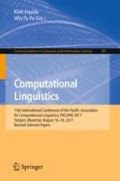Abstract
Relational similarity measures the correspondence of the semantic relations that exist between the two words in word pairs. Accurately measuring relational similarity is important for various natural language processing tasks such as, relational search, noun-modifier classification, and analogy detection. Despite this need, the features that accurately express the relational similarity between two word pairs remain largely unknown. So far, methods have been proposed based on linguistic intuitions such as the functional space proposed by Turney [1], which consists purely of verbs. In contrast, we propose a data-driven approach for discovering feature spaces for relational similarity measurement. Specifically, we use a linear-SVM classifier to select features using training instances, where two pairs of words are labeled as analogous or non-analogous. We evaluate the discovered feature space by measuring the relational similarity for relational classification task in which we aim to classify a given word-pair to a specific relation from a predefined set of relations. Linear classifier for ranking the best feature for relational space has been compared with different methods namely, Kullback Leibler divergence (KL), Pointwise Mutual Information (PMI). Experimental results show that our proposed classification method accurately discovers a discriminative features for measuring relational similarity. Furthermore, experiments show that the proposed method requires small number of relational features while still maintaining reasonable relational similarity accuracy.
Access this chapter
Tax calculation will be finalised at checkout
Purchases are for personal use only
Notes
- 1.
- 2.
The corpus was collected by Charles Clarke at the University of Waterloo.
- 3.
- 4.
References
Turney, P.D.: Domain and function: a dual-space model of semantic relations and compositions. J. Aritif. Intell. Res. 44, 533–585 (2012)
Bollegala, D., Matsuo, Y., Ishizuka, M.: A relational model of semantic similarity between words using automatically extracted lexical pattern clusters from the web. In: Proceedings of the Empirical Methods in Natural Language Processing, pp. 803–812 (2009)
Turney, P.D.: A uniform approach to analogies, synonyms, antonyms, and associations. In: Proceedings of the 22nd International Conference on Computational Linguistics (Coling 2008), pp. 905–912 (2008)
Nakov, P., Kozareva, Z.: Combining relational and attributional similarity for semantic relation classification. In: Proceedings of the Recent Advances in Natural Language Processing, pp. 323–330 (2011)
Duc, N.T., Bollegala, D., Ishizuka, M.: Using relational similarity between word pairs for latent relational search on the web. In: IEEE/WIC/ACM International Conference on Web Intelligence and Intelligent Agent Technology, pp. 196–199 (2010)
Riedel, S., Yao, L., McCallum, A., Marlin, B.M.: Relation extraction with matrix factorization and universal schemas. In: Proceedings of the North American Chapter of the Association for Computational Linguistics: Human Language Technologies, pp. 74–84 (2013)
Turney, P.D.: Similarity of semantic relations. Comput. Linguist. 32(3), 379–416 (2006)
Turney, P.D.: Distributional semantics beyond words: supervised learning of analogy and paraphrase. Trans. Assoc. Computat. Linguist. 1, 353–366 (2013)
Landauer, T.K., Foltz, P.W., Laham, D.: An introduction to latent semantic analysis. Discourse Process. 25(2–3), 259–284 (1998)
Turney, P.D.: Measuring semantic similarity by latent relational analysis. In: Proceedings of the International Joint Conference on Artificial Intelligence, pp. 1136–1141 (2005). arXiv preprint arXiv:cs/0508053
Tripathi, G., Naganna, S.: Feature selection and classification approach for sentiment analysis. Mach. Learn. Appl. Int. J. 2(2), 1–16 (2015)
Brank, J., Grobelnik, M., Milic-Frayling, N., Mladenic, D.: Feature selection using support vector machines. WIT Trans. Inf. Commun. Technol. 28 (2002)
Mladenić, D., Brank, J., Grobelnik, M., Milic-Frayling, N.: Feature selection using linear classifier weights: interaction with classification models. In: Proceedings of the 27th Annual International ACM SIGIR Conference on Research and Development in Information Retrieval, pp. 234–241. ACM (2004)
Ji, Y., Eisenstein, J.: Discriminative improvements to distributional sentence similarity. In: Proceedings of the Empirical Methods in Natural Language Processing, pp. 891–896 (2013)
Xu, Y., Jones, G.J., Li, J., Wang, B., Sun, C.: A study on mutual information-based feature selection for text categorization. J. Comput. Inf. Syst. 3(3), 1007–1012 (2007)
Schneider, K.-M.: Weighted average pointwise mutual information for feature selection in text categorization. In: Jorge, A.M., Torgo, L., Brazdil, P., Camacho, R., Gama, J. (eds.) PKDD 2005. LNCS (LNAI), vol. 3721, pp. 252–263. Springer, Heidelberg (2005). https://doi.org/10.1007/11564126_27
Vylomova, E., Rimmel, L., Cohn, T., Baldwin, T.: Take and took, gaggle and goose, book and read: evaluating the utility of vector differences for lexical relation learning. In: Proceedings of the Association for Computational Linguistics, pp. 1671–1682 (2016)
Turney, P.D., Neuman, Y., Assaf, D., Cohen, Y.: Literal and metaphorical sense identification through concrete and abstract context. In: Proceedings of the Empirical Methods in Natural Language Processing, pp. 27–31 (2011)
Author information
Authors and Affiliations
Corresponding author
Editor information
Editors and Affiliations
Rights and permissions
Copyright information
© 2018 Springer Nature Singapore Pte Ltd.
About this paper
Cite this paper
Hakami, H., Mandya, A., Bollegala, D. (2018). Discovering Representative Space for Relational Similarity Measurement. In: Hasida, K., Pa, W. (eds) Computational Linguistics. PACLING 2017. Communications in Computer and Information Science, vol 781. Springer, Singapore. https://doi.org/10.1007/978-981-10-8438-6_7
Download citation
DOI: https://doi.org/10.1007/978-981-10-8438-6_7
Published:
Publisher Name: Springer, Singapore
Print ISBN: 978-981-10-8437-9
Online ISBN: 978-981-10-8438-6
eBook Packages: Computer ScienceComputer Science (R0)

